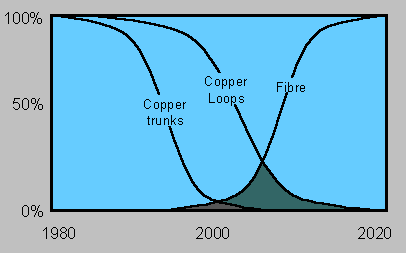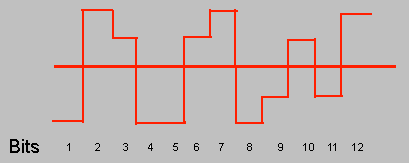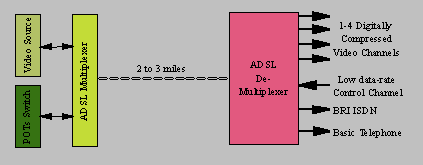Copper Local-Loop Defunct? No Way! (DSL)
� Mercury Communications Ltd - Aug 1993
![]() 2007
network writings:
2007
network writings:
![]() My
TechnologyInside blog
My
TechnologyInside blog
With the extensive deployment of optical fibre by telecommunications operators and the many column inches dedicated to the subject of fibre-for-all in the technical and local press it is easy to fall into the trap of believing what you read!
While it is certainly true that fibre-to-the-home, fibre-to-the-kerb, or even fibre-the-SME (small and medium enterprise) will provide almost unlimited bandwidth for almost any type of service that could possibly be imagined, the installation of such a network would require almost an unlimited budget as well. However the biggest challenge is that it still very early days for most of the innovative services that TOs could deliver over such a network and it would require a real zealot to justify the expenditure on the basis of low near-term revenues. The challenge is so immense that it really requires governmental commitment and finance and, although this been the case in several countries world-wide, we are unlikely to see it in the UK in the near term.
Because it is so easy to get carried away by vision it is easy to overlook one of the most ubiquitously deployed technologies potentially available to all - namely copper. You might be tempted to think that this is all well and good but surely copper is only capable of delivering traditional telephony services and low data-rate data using modems? Wrong! As we have seen in many of the Technology Watches, new technologies, in this case new compression algorithms and modulation methods, are bringing about a transformation in this overlooked and much under-utilised resource.
Asymmetric digital subscriber loop (ADSL) and high-bit-rate digital subscriber loop (HDSL) are two new technologies that are capable of driving high bit-rates data over existingcopper local-loops. As we shall see, achievable data rates are only limited by the length and the quality of the copper twisted pair. For example, HDSL can achieve up to 2Mbit/s over two twisted pair cables up to a distance of 2 to 3 miles.
Although it is a pretty safe assumption to suggest that in the next century most businesses and homes will connected by fibre, there is an urgent need in the near term for a low-cost technology that would allow TOs and 3rd party service providers to experiment and gain confidence in the provision of services such as interactive video, on-line shopping, office and home banking, and for businesses to be able to interconnect LANs at megabit data-rates at affordable prices. HDSL and ADSL are capable of meeting these needs.
The Prevailing View
The traditional view of fibre deployment and the demise of copper is shown in Figure 1. This perspective is driven by the view that the world of the next decade will be all broadband fibre based using asynchronous transfer mode (ATM) and synchronous digital hierarchy (SDH) to transfer data around the world's network at rates in excess of 1Gbit/s. Again, it would be a reasonably safe bet to assume that by the year 2020 this would be the case. However, in the mid 1990s the cost of upgrading existingnetworks would require an investment of hundreds of millions of pounds. So it is likely that the development budgets of TOs would only allow a modest increase in the provision of these broadband services on a year-on-year basis which will result in 'pockets of deployment'. Although it will be interesting to see what the effect of new start-up TOs will be on the market as they are not constrained by an existing network and will opt for SDH and ATM straight off.

Figure 1 -Conceptual model of Fibre Deployment
What would it really take to bring broad band services to the world at large? The ideal solution would be a low-cost transmission system that could instantly upgrade any existing local exchange link to be capable of supporting broadband with no changes to buried copper plant and only enhancement of the termination equipment at either end of the link.
To support most of the services being considered in new-world telecommunications, SDH data-rates are an overkill and would probably be unaffordable by a significant parts of the market. Using moving picture experts group (MPEG) compression on standard European PAL video it is now possible to achieve PAL quality video (or at least very close to it) at digital data-rates between 1 to 2 Mbit/s. Thus using ADSL technology, interactive or broadcast video can be pumped into the home over standard twisted-pair copper local-loop up to a distance of two miles. Even higher bit rates are possible over shorter distances.
Technology Overview
The vast majority of copper local loops only carry analogue voice signals over a very narrow band of audio frequencies and until recently the major digitalisation of TO networks has had very little impact on them. When TOs expanded their network in the past, hundreds of subscriber loops were bundled together as multi-paired cables. These were usually buried in the ground or, in remote locations, hung on distribution poles. Many have been in place for decades and carry a complex mix of direct and alternating current, audio tones, dialling pulses and voice signals. They pick up interference from many external sources such as noise from overhead power-lines, arcing electrical machinery, and private mobile radio (PMR) transmissions as used by taxi operators. These cables are also very poor transmission lines and suffer problems such as high-frequency attenuation, signal reflections from the terminations (resulting in echo), excessive signal delay, signal distortion, and crosstalk . Longer cables can consist of several sections of different gauge wire and can contain isolating and noise neutralising transformers. All of which reduce the cable's ability to carry wide band data.
A single twisted-pair cable can carry voice in both directions at the same time without interference, but they unable to do this for digital pulse code modulation (PCM) signals. Two-way digital telephone requires either two pairs of wires or a active digital echo canceller as used in integrated services digital network (ISDN).
Over the last decade it has been possible to increase achievable data rates over copper by taking advantage of several new developments:
Modem Technology
New modem technologies have increased achievable data-rates by leaps and bounds. This has been achieved using a mixture of data compression, multi-level amplitude, and frequency / phase modulation techniques. As a result, dial-up modems have virtually doubled their data rates every year. For example, the newly proposed Vfast standard supports a raw data rate of 19.4 Kbits/s and, with data compression, up to 28 Kbit/s.
Digital Echo Cancellation
Echoes in copper cables cause a high level of bit-rate errors with digital transmission and although echo-cancellation with analogue signals is considered to be very difficult, it is now relatively straightforward in digital circuits. The use of digital signal processing (DSP) techniques makes it possible to analyse bi-directional data streams in real time and filter out unwanted echoes.
Modulation Techniques
The third ingredient that has helped speed up data transmission is improved ways of transmitting binary digits otherwise known as modulation. Today there are two fundamental ways of achieving this, 2B1Q and CAP.
2B1Q
Two binary one quaternary (2B1Q) modulation exhibits similar transmission characteristics to analogue signals when transmitted over copper loops. The spectrum of signals transmitted by 2B1Q extends from zero to over 1.5MHz (Figure 2). This is because of the multi-level bit modulation technique used (Figure 3). This limits the use of this baseband technique to short distances as the bandwidth for 12,000 feet of 24-gauge twisted pair is only 400Khz. It not at all suitable for very high bit-rate systems.

Figure 2 - Spectrum of 2B1Q Modulation

Figure 3 - The 2B1Q Modulation Technique
Carrierless Amplitude/Phase Modulation (CAP)
By utilising the developments of the modem world combined with digital echo cancellation it is now possible to transmit the data stream as a multi-level amplitude and phase modulated waveform.
CAP is an example of such a bandwidth efficient code. Recent technological advances in semiconductor technology and DSP techniques have enabled the practical application of CAP at data-rates up to 155Mbit/s. CAP is closely associated with quadrature amplitude modulation (QAM) in that it uses 32 levels of signal amplitude and phase (known as Trellis coding) to conserve bandwidth. In effect, CAP can transmit 2 Mbit/s of data over a bandwidth as narrow as 180kHz (Figure 4).

Figure 4 - Spectrum of 4-wire CAP Modulation
Vfast uses CAP transmission techniques as does HDSL. Bellcore have recommended that near-term HDSL products be based on 2B1Q technology but the T1E1.2 working group are studying several alternatives, including CAP, for use with ADSL.
As in the field of personal communications systems where the protagonists of TDD and CDMA are slugging it out in a battle to the death so it is with 2B1Q and CAP. 2B1Q is available now and will gain ground with early deployment, but CAP is there in the wings waiting for its chance.
HDSL Services
HDSL is aimed at the business market to transport LAN and computer data at E1 rates. It is still early days, but it is likely that wide scale deployment will be seen over the next few as a pragmatic alternative to fibre for those than can access copper local loops. HDSL supports high-bit rate data transmission over twisted pair. It is a symmetric technology in that it allows bi-directional data transmission at 2Mbit/s (i.e. full duplex ) over a 2-wire circuit. See table 1.
Application Data Rate Distance
2-wire HDSL Duplex 2 10,000 feet
Mbit/s
4-wire HDSL Duplex 784 18,000 feet
Kbit/s
Table 1 - HDSL Services
HDSL can be used as a replacement for a fibre E1 circuit and provides an almost ideal way of delivering high data-rate LAN-to-LAN connection capability for small and medium enterprises. Of course, HDSL can be also be used for delivering H.320 based video services as well.
HDSL products are now beginning to appear on the market e.g.
- June 1993. "RAD Data Communications announces the availability of ASM-400 which uses four twisted-pairs to transport full E1 payload or two twisted-pairs to deliver half and E1 payload. The four-pair system splits the E1 bandwidth into two lines by sending a data stream of 1,88 Kbit/s over each line. The data streams are then recombined at the other end to provide a full E1 signal."
- June 1993. "AT&T Paradyne announces new technology that will accelerate new video, data, and voice services. Paradyne will offer two-wire and four-wire HDSL and will utilise carrierless / amplitude phase modulation (CAP) transmission technology."
- June 1993. AT&T Paradyne announces a four-wire very-high HDSL (VHDSL) capable of transporting 3 Mbit/s over copper cable. Previously TOs only considered using fibre for delivery of broad band services.
ADSL Services
When the US Federal Communications Commission (FCC) decided in July 1992 to allow regional Bell operating companies(RBOCs) to carry video traffic but not originateit, several initiated trial services known as video dialtone. This move met with a frosty reception as RBOCs thought they were only getting the low-margin part of the deal rather than the more lucrative video origination business.

Figure 5 - ADSL for video, Data, and Telephony Service Delivery to the Home
In the UK, British Telcom is prohibited from providing entertainment services until later this decade. It is interesting to note that the regulatory wording talks about 'entertainment' i.e. television and video film distribution. However, it could be conjectured that the largest part of a future video market will be business video i.e. delivery of services such as home shopping and home banking.
It was originally thought that transmission of video by a TO would speed deployment of fibre but it is looking more like that in the near term video will be delivered on traditional copper using ADSL. ADSL is currently under development (and being field-trailed by British Telecom) and will allow TOs to transmit compressed video traffic at 2 Mbit/s into homes over the same piece of copper currently delivering telephone services. In addition, ADSL would permit a reverse low-speed connection of 16 or 32 Kbit/s between the customer and the TO (Figure 5 and Table 2). This would provide the functionality for interactive video services, program selection, and menu item selection.
As with HDSL, ADSL transmitted over copper suffers significant signal loss and cannot be considered as a long term solution to question of broad band. However, it is adequate for near-term delivery of video services to the home.
Application Data Rate Distance 2-wire ->2 Mbit/s, 18,000 ADSL <-16-32 Kbit/s feet
Table 2 - ADSL Service
ADSL is not only intended for the delivery of interactive video services to the home, as the T1E1.4 committee standard extends to include a bi-directional 384 Kbit/s data channel and a standard telephone line that is still functional even with a power cut in the home.
Roundup
Although it is shrewd to support the view that by 'sometime' in the next decade all homes and businesses will be linked by a 'ubiquitous' fibre broad band network, it is clear this will not happen over night. Financial justification of such a network will be based on the success of new services trailed and deployed over the next few years. Better utilisation of the existing �20Bn copper local-loop infrastructure in the UK is inevitable and the technology that provides this capability is 2B1Q or CAP based HDSL and ADSL.
Interest in copper is about to see a resurgence. In the UK the major question that needs to be answered is how it can be accessed by the new TOs. Open Network Provision (ONP), if it provides and answer to this, will be on everyone's lips soon. How else can TOs deliver data, telephony and video services to direct the home in the near term? ADSL answers many questions, its deployment will raise many more.
